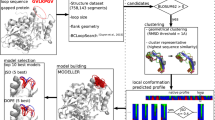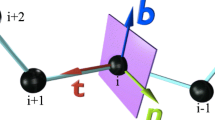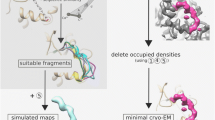Abstract
Methods to predict the structure of a protein often rely on the knowledge of macro sub-structures and their exact or approximated relative positions in space. The parts connecting these sub-structures are called loops and, in general, they are characterized by a high degree of freedom. The modeling of loops is a critical problem in predicting protein conformations that are biologically realistic. This paper introduces a class of constraints that models a general multi-body system; we present a proof of NP-completeness and provide filtering techniques, inspired by inverse kinematics, that can drastically reduce the search space of potential conformations. The paper shows the application of the constraint in solving the protein loop modeling problem, based on fragments assembly.
Access this chapter
Tax calculation will be finalised at checkout
Purchases are for personal use only
Preview
Unable to display preview. Download preview PDF.
Similar content being viewed by others
References
Backofen, R., Will, S.: A Constraint-Based Approach to Fast and Exact Structure Prediction in 3-Dimensional Protein Models. Constraints 11(1), 5–30 (2006)
Barahona, P., Krippahl, L.: Constraint programming in structural bioinformatics. Constraints 13(1-2), 3–20 (2008)
Ben-David, M., Noivirt-Brik, O., Paz, A., Prilusky, J., Sussman, J.L., Levy, Y.: Assessment of CASP8 structure predictions for template free targets. Proteins 77, 50–65 (2009)
Best, M., Bhattarai, K., Campeotto, F., Dal Pal’u, A., Dang, H., Dovier, A., Fioretto, F., Fogolari, F., Le, T., Pontelli, E.: Introducing FIASCO: Fragment-based Interactive Assembly for protein Structure prediction with COnstraints. In: Proc. of Workshop on Constraint Based Methods for Bioinformatics (2011), http://www.dmi.unipg.it/WCB11/wcb11proc.pdf
Cahill, S., Cahill, M., Cahill, K.: On the kinematics of protein folding. Journal of Computational Chemistry 24(11), 1364–1370 (2003)
Canutescu, A., Dunbrack, R.: Cyclic coordinate descent: a robotics algorithm for protein loop closure. Protein Sci. 12, 963–972 (2003)
Choi, Y., Deane, C.M.: FREAD revisited: Accurate loop structure prediction using a database search algorithm. Proteins 78(6), 1431–1440 (2010)
Dal Palù, A., Dovier, A., Fogolari, F.: Constraint logic programming approach to protein structure prediction. BMC Bioinformatics 5, 186 (2004)
Dal Palù, A., Dovier, A., Fogolari, F., Pontelli, E.: CLP-based protein fragment assembly. TPLP 10(4-6), 709–724 (2010)
Dal Palù, A., Dovier, A., Fogolari, F., Pontelli, E.: Exploring Protein Fragment Assembly Using CLP. In: Walsh, T. (ed.) IJCAI, pp. 2590–2595. IJCAI/AAAI (2011)
Dal Palù, A., Dovier, A., Pontelli, E.: A constraint solver for discrete lattices, its parallelization, and application to protein structure prediction. Softw., Pract. Exper. 37(13), 1405–1449 (2007)
Dal Palù, A., Dovier, A., Pontelli, E.: Computing approximate solutions of the protein structure determination problem using global constraints on discrete crystal lattices. IJDMB 4(1), 1–20 (2010)
Dal Palù, A., Spyrakis, F., Cozzini, P.: A new approach for investigating protein flexibility based on Constraint Logic Programming: The first application in the case of the estrogen receptor. European Journal of Medicinal Chemistry 49, 127–140 (2012)
Deane, C., Blundell, T.: CODA. A combined algorithm for predicting the structurally variable regions of protein models. Protein Sci. 10, 599–612 (2001)
Dotú, I., Cebrián, M., Van Hentenryck, P., Clote, P.: On Lattice Protein Structure Prediction Revisited. IEEE/ACM Trans. Comput. Biology Bioinform. 8(6), 1620–1632 (2011)
Felts, A., Gallicchio, E., Chekmarev, D., Paris, K., Friesner, R., Levy, R.: Prediction of protein loop conformations using AGBNP implicit solvent model and torsion angle sampling. J. Chem. Theory Comput. 4, 855–868 (2008)
Fiser, A., Do, R., Sali, A.: Modeling of loops in protein structures. Protein Sci. 9, 1753–1773 (2000)
Fogolari, F., Pieri, L., Dovier, A., Bortolussi, L., Giugliarelli, G., Corazza, A., Esposito, G., Viglino, P.: Scoring predictive models using a reduced representation of proteins: model and energy definition. BMC Structural Biology 7(15), 1–17 (2007)
Fujitsuka, Y., Chikenji, G., Takada, S.: SimFold energy function for de novo protein structure prediction: consensus with Rosetta. Proteins 62, 381–398 (2006)
Hartenberg, R., Denavit, J.: A kinematic notation for lower pair mechanisms based on matrices. Journal of Applied Mechanics 77, 215–221 (1995)
Jacobson, M., Pincus, D., Rapp, C., Day, T., Honig, B., Shaw, D., Friesner, R.: A hierarchical approach to all-atom protein loop prediction. Proteins 55, 351–367 (2004)
Jamroz, M., Kolinski, A.: Modeling of loops in proteins: a multi-method approach. BMC Struct. Biol. 10(5) (2010)
Jauch, R., Yeo, H., Kolatkar, P.R., Clarke, N.D.: Assessment of CASP7 structure predictions for template free targets. Proteins 69, 57–67 (2007)
Jones, D.: Predicting novel protein folds by using FRAGFOLD. Proteins 45, 127–132 (2006)
Karplus, K., Karchin, R., Draper, J., Casper, J., Mandel-Gutfreund, Y., Diekhans, M., Source, R.H.: Combining local structure, fold-recognition, and new fold methods for protein structure prediction. Proteins 53(6), 491–497 (2003)
Kinch, L., Yong Shi, S., Cong, Q., Cheng, H., Liao, Y., Grishin, N.V.: CASP9 assessment of free modeling target predictions. Proteins 79, 59–73 (2011)
LaValle, S.: Planning Algorithms. Cambridge University Press (2006)
Lee, J., Kim, S., Joo, K., Kim, I., Lee, J.: Prediction of protein tertiary structure using profesy, a novel method based on fragment assembly and conformational space annealing. Proteins 56(4), 704–714 (2004)
Lee, J., Lee, D., Park, H., Coutsias, E., Seok, C.: Protein Loop Modeling by Using Fragment Assembly and Analytical Loop Closure. Proteins 78(16), 3428–3436 (2010)
Liu, P., Zhu, F., Rassokhin, D., Agrafiotis, D.: A self-organizing algorithm for modeling protein loops. PLOS Comput. Biol. 5(8) (2009)
Rapp, C.S., Friesner, R.A.: Prediction of loop geometries using a generalized born model of solvation effects. Proteins 35, 173–183 (1999)
Shen, M., Sali, A.: Statistical potential for assessment and prediction of protein structures. Protein Sci. 15, 2507–2524 (2006)
Shmygelska, A., Hoos, H.: An ant colony optimisation algorithm for the 2D and 3D hydrophobic polar protein folding problem. BMC Bioinformatics 6 (2005)
Simons, K., Kooperberg, C., Huang, E., Baker, D.: Assembly of protein tertiary structures from fragments with similar local sequences using simulated annealing and bayesian scoring functions. J. Mol. Biol. 268, 209–225 (1997)
Spassov, V., Flook, P., Yan, L.: LOOPER: a molecular mechanics-based algorithm for protein loop prediction. Protein Eng. 21, 91–100 (2008)
Xiang, Z., Soto, C., Honig, B.: Evaluating conformal energies: the colony energy and its application to the problem of loop prediction. PNAS 99, 7432–7437 (2002)
Zhou, H., Zhou, Y.: Distance-scaled, finite ideal-gas reference state improves structure-derived potentials of mean force for structure selection and stability prediction. Protein Sci. 11, 2714–2726 (2002)
Author information
Authors and Affiliations
Editor information
Editors and Affiliations
Rights and permissions
Copyright information
© 2012 Springer-Verlag Berlin Heidelberg
About this paper
Cite this paper
Campeotto, F., Dal Palù, A., Dovier, A., Fioretto, F., Pontelli, E. (2012). A Filtering Technique for Fragment Assembly- Based Proteins Loop Modeling with Constraints. In: Milano, M. (eds) Principles and Practice of Constraint Programming. CP 2012. Lecture Notes in Computer Science, vol 7514. Springer, Berlin, Heidelberg. https://doi.org/10.1007/978-3-642-33558-7_61
Download citation
DOI: https://doi.org/10.1007/978-3-642-33558-7_61
Publisher Name: Springer, Berlin, Heidelberg
Print ISBN: 978-3-642-33557-0
Online ISBN: 978-3-642-33558-7
eBook Packages: Computer ScienceComputer Science (R0)




